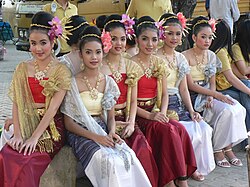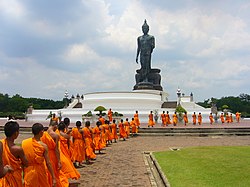User:Belfras/Sandbox10: Difference between revisions
No edit summary |
|||
| Line 26: | Line 26: | ||
|latd= | |latd= | ||
|longd= | |longd= | ||
|largest_city = | |largest_city = | ||
|largest_settlement = | |largest_settlement = | ||
|largest_settlement_type = | |largest_settlement_type = | ||
| Line 98: | Line 98: | ||
|HDI_rank = | |HDI_rank = | ||
|HDI_year = | |HDI_year = | ||
|currency = | |currency = Tepis | ||
|currency_code =''TP/В₽'' | |currency_code =''TP/В₽'' | ||
|time_zone = | |time_zone = | ||
| Line 179: | Line 179: | ||
As previously stated, the tenets of Margaya allow the existence and participation of it's own practitioners in other religions if they so desire. As a result other religions, such as [[Albanism]] and XXXX also exist in the country. [[Albanism]] is mostly concentrated in the country's south-western most provinces. | As previously stated, the tenets of Margaya allow the existence and participation of it's own practitioners in other religions if they so desire. As a result other religions, such as [[Albanism]] and XXXX also exist in the country. [[Albanism]] is mostly concentrated in the country's south-western most provinces. | ||
[[File:Phutthamonthon Buddha.JPG|250px|thumbnail|left|Margaya Monks at the statue of Teras Kol, | [[File:Phutthamonthon Buddha.JPG|250px|thumbnail|left|Margaya Monks at the statue of Teras Kol, Nilagne Naegima.]] | ||
In the socialist constitution of 1950, the state recognises the prevalence of Margaya and it's place as the state's primary religion through popularity and it's integration with the people's culture and national identity. It does, however, state that the people of the nation may be free to practice religions to their own desires so long as it does not provoke 'rebellious intentions against the state or cause one to begin disturbing the national harmony'. In practice, this allows religious organisations free license to operate in the country and missionaries are present in large numbers throughout the nation. While the nation has a highly questionable human rights record and reports of abuses are common, it is notable that no widespread reports of abuses or discrimination directed toward religious missionaries or people of other religious beliefs not associated with Margaya exist. This has been put down by multiple sources as a direct result of Margaya's tenets toward religious acceptance. | In the socialist constitution of 1950, the state recognises the prevalence of Margaya and it's place as the state's primary religion through popularity and it's integration with the people's culture and national identity. It does, however, state that the people of the nation may be free to practice religions to their own desires so long as it does not provoke 'rebellious intentions against the state or cause one to begin disturbing the national harmony'. In practice, this allows religious organisations free license to operate in the country and missionaries are present in large numbers throughout the nation. While the nation has a highly questionable human rights record and reports of abuses are common, it is notable that no widespread reports of abuses or discrimination directed toward religious missionaries or people of other religious beliefs not associated with Margaya exist. This has been put down by multiple sources as a direct result of Margaya's tenets toward religious acceptance. | ||
Revision as of 17:44, 10 April 2020
Socialist Republic of Ankat අන්කට් සමාජවාදී ජනරජය (Terasi) ankaṭ samājavādī janarajaya | |
|---|---|
| Motto: ටෙරාස් කෝල්ගේ ආලෝකයෙන් අපි නැගී සිටිමු "ṭerās kōlgē ālōkayen api nægī siṭimu" "In the light of Teras Kol we stand" | |
| Anthem:
අපි ඔහුගේ ප්රතිරූපය තුළ වැඩ කරමු "api ohugē pratirūpaya tuḷa væḍa karamu" "We work in his image" | |
| Capital | Nilagne Naegima |
| Official languages | Terasi |
| Demonym(s) | Ankati |
| Government | Unitary one-party socialist republic |
| Suneshka Iriyagolla | |
| Eshan Silva | |
| Samithra Malinga | |
| Legislature | National Assembly |
| Formation | |
| Population | |
• 2019? estimate | 103,235,813? |
• 2013? census | 99,895,720? |
| GDP (PPP) | 2019? estimate |
• Total | $2.374 trillion? |
• Per capita | $23,000? |
| Currency | Tepis (TP/В₽) |
| Date format | dd.mm.yyyy |
| Driving side | left |
| Calling code | +69420 |
| ISO 3166 code | ANK |
| Internet TLD | .msv |
Ankat (Terasi: අන්කට්), officially the Socialist Republic of Ankat (Terasi: අන්කට් සමාජවාදී ජනරජය)
History
Geography
Climate
Government and politics
Foreign relations
Military
The Ankati Armed Forces was created as part of the sweeping overhauls following the revolution of 1948. It had previously been known as the Ibid Freedom Army (IFA) and from 1904 till 1945 had been pushed into guerrilla warfare by the military of the old regime. The Armed Forces consists of the Army, Navy, and the Air Force. The Navy operates the nation's coast guard as part of it's Naval Auxiliary.
The Socialist Republic operates a national service, and every male and female has to serve at least three years in the Armed Forces from the age of 16 to 22, those who try to avoid national service are typically subjected to jail terms. The professional service of the military is voluntary in peace-time, and typically offers more than what most Ankati would encounter in civilian life.
Administrative divisions
Human rights issues
Economy
Agriculture
Science and technology
Infrastructure
Transport
Demographics
Culture
This section includes participation of other members of Ajax that has not yet been confirmed or sought out and is, therefore, to be considered WIP and to-be-confirmed.
The national culture of Ankat has evolved greatly over time, from it's isolationism whilst ruled over by it's monarchy during the Walpoli era, to the rapid influx of trade and immigrants after Mutulese conquest of Ankat. Following the withdrawal of Mutulese imperialism in XXXX, the Ankat Republic of the Attunippi era absorbed influences from all over Ochran and some from western Scipia. Strong Tsurushimese, Fahrani, Mutulese, and other influences are still evident in traditional and modern Ankati culture. Modernisation brought in by traders from Oxidentale, Norumbria, and chiefly Belisaria played a significant role in shaping it's modern culture.
Modern culture of Ankat is in itself considered a wholly different animal to the traditional cultural ways and methods, sometimes differentiated in being named the Terasi culture. The origin of the modern culture can be traced to the socialist reformation of government in 1948, with the first government adopting Belisarian trends of nationalism and industrialisation that also brought with it sweeping agricultural and transportation improvements throughout the nation. Sweeping reforms enacted throughout this period and the after-effects of the Attunippi era has also had lasting impacts on the nation's primary religion, Margaya .
Literature
Religion

Ankat's most prevalent religion, and it's state religion, is Margaya (මාර්ගය, lit. 'The Way'), which is also an integral part of the Ankati identity and culture. The connection between the people of Ankat and Margaya is prevalent in every-day life to an extent that in a 2005 census 98% of the country's population self-identified as Margaya in one of two emerging sects - An active participation in the religion and a passive participation which allows the person the ability to convert to other religions and still be considered a 'part' of the Margaya faith, as the defining tenets of Margaya is easily interpreted as a "love of all and an acceptance of all". Monks of Margaya worship at monasteries around the country and the world, offering interpretation of the Tenets of Teras Kol (ටෙරාස් කෝල්), the first spiritual leader of Ankat believed to have lived in the 5th century BCE. The Margaya faith is centered around Bhagyavatun Vahanse (Blessed City), which is the world's largest religious site and was
As previously stated, the tenets of Margaya allow the existence and participation of it's own practitioners in other religions if they so desire. As a result other religions, such as Albanism and XXXX also exist in the country. Albanism is mostly concentrated in the country's south-western most provinces.
In the socialist constitution of 1950, the state recognises the prevalence of Margaya and it's place as the state's primary religion through popularity and it's integration with the people's culture and national identity. It does, however, state that the people of the nation may be free to practice religions to their own desires so long as it does not provoke 'rebellious intentions against the state or cause one to begin disturbing the national harmony'. In practice, this allows religious organisations free license to operate in the country and missionaries are present in large numbers throughout the nation. While the nation has a highly questionable human rights record and reports of abuses are common, it is notable that no widespread reports of abuses or discrimination directed toward religious missionaries or people of other religious beliefs not associated with Margaya exist. This has been put down by multiple sources as a direct result of Margaya's tenets toward religious acceptance.
Cuisine
Ankati cuisine is made up of a large variety of regional and traditional cuisines. Cuisine differs across the country as a result of variation in geographical location (proximity to sea, mountains, plains) and economics. It also varies seasonally, depending on what fruits and vegetables are ripe. The usage of spices and rice in food preparation is common throughout all varieties of Ankati food and for some dishes the preparation is the same regardless of type of meat used (pork, chicken or beef.) A notable difference in preparations only exists in regards to fish, which are typically cooked with honey, fruits and typically without rice.
One of the most popular types of cuisine that Ankat has to offer comes from the Bibila province which is widely considered the agricultural center of the nation. Bibila is highly abundant in whole grains, vegetables and fruits. Bibilan cuisines can vary significantly depending on if it's home-cooked or made by a restaurant. Restaurant-style Bibilan cuisine often puts an emphasis on a creamy, rich texture using ghee, butter and cream while home-cooked meals often center around whole wheat, rice and either garam or masala flavored ingredients. The usage of pasta has grown since being introduced to the country from Latium. Local Bibilan courses include yogurt-based roti, daal and dahi often served with chutney and a light salad.
Common Babilan dishes are also abundant with local and seasonal vegetables often sauteed with spices such as cumin, dried coriander, red chili powder, etc. The mixing of tea with spices results in Masala Chai, a favorite drink of many in Ankat and is considered a part of the national diet. Bibilan food is considered highly versatile and many differences can be found throughout the country with differing food combinations, spice combinations, the absence, increase, or difference in fruits and vegetables used in cooking.
The drinking of tea is incredibly common throughout Ankat. One of the main tenets of Margaya goes against intoxication, and as a result as many as 74% of the population can be considered as teetotal. Ankat is one of the world's largest producers of tea, and varieties of tea grown include Assam, Nilgiri and Tarak tea which is often drunk by Margaya monks during ceremonies. The preparation of Tarak Tea, involving a mixture of water, milk and spices often mean that in homes it is produced in a large batch in a vessel known as a Tappid which cycles heat to keep the brewed liquid hot while also being enclosed to keep flies or other water-borne insects from gaining access to the tea. It is considered an Ankati ancestor to the kettle. Coffee is another popular beverage of Ankat and is cultivated in the southern provinces.





